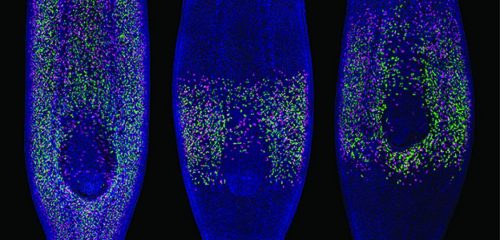Worm study reveals role of stem cells in cancer
Posted by ZoologyOxford, on 3 October 2017
A new study carried out by the University of Oxford has used flat worms to look at the role of migrating stem cells in cancer
Researchers from the Aboobaker lab in the Department of Zoology used the worms (planarians) which are known for their ability to regenerate their tissues and organs repeatedly. This process is enabled by their stem cells, which constantly divide to make new cells.
Cell migration – or the movement of cells from one part of the body to another – is a key function of cells in our bodies. New stem cells are constantly required to maintain tissue and organs functions, and they are expected to migrate to where they are needed. However, control of these movements can fail, and cancers can form when these cells migrate to places they aren’t supposed to be.
By understanding how stem cells are programmed to move, what activates them and how they follow a correct path, researchers may be able to design new treatments for cancer.
‘We already knew that these worm stem cells have a lot in common with our own stem cells, but we knew nothing about how they migrate and if this process relates to how our cells migrate,’ says Dr Prasad Abnave, first author of the study, published in Development.

‘We wanted to establish if the same mechanisms had been evolutionary conserved or not, we hoped that they would be, as this would make an excellent model for studying all aspects of stem cell migration.’
However, before the team could start working with the worms, they had to overcome a small problem. ‘Perhaps a little counterintuitively, the sheer abundance of stem cells in planarians makes it difficult to study migration,’ said Professor Aziz Aboobaker.
‘In order to trace the movement of cells you need to create a field for them to move into so you can be sure of the direction and speed at which their moving, but if the cells you are interested in are already everywhere that is difficult to do.’
Luckily the team were able to draw on over 100 years of previous work. In one particular experiment that used x-rays to kill planarian stem cells, it was found that the animals survived the treatment if part of the worm was kept under a lead shield, as ‘presumably the stem cells under the lead shield migrate to the rest of the animal and everything is fine.’ said Abnave.
With the help of Dr Mark Hill at Oxford’s Department of Oncology the group were able to design an apparatus that allowed them to use X-rays to leave behind a thin strip of stem cells. These cells could then be observed as they migrated through the rest of the organism to where the original stem cells had been killed.
‘This collaboration gave us a great opportunity to apply previous experience gained in studying cancer cells to a study involving cells in a whole organism. It will provide a useful tool to improve our understanding of stem cells, and their potential role in cancer,’ said Mark.
‘It sounds simple, but it took a long time to design an apparatus and techniques with which we could study many worms at once. That was key in being able to study how migration was controlled and for performing high quality experiments that could really generate reproducible results,’ said Aboobaker.
Professor Gillies McKenna, the Director of the CRUK / MRC Institute for Radiation Oncology and Biology commented: ‘This project is an example of why Oxford is such a rewarding place to do research. People from different departments and disciplines bringing their expertise together to tackle a problem neither could do alone but together shedding new light on both fundamental biology and also on cancer.’
By studying how the worms respond to injury, the team found that stem cells migrated very precisely to the affected area. However in the absence of damaged tissue the cells sat still and did not migrate.
Using a technique called RNA interference the team were then able to remove the function of regulatory genes already known to be important in cell migration (and to play a role in human cancers) and found that they were all also required for migration of planarians stem cells. These genes included proteins known as transcription factors that are important because they act as ON/OFF switches for hundreds of other genes.
‘This was a very satisfying result as it confirmed our suspicion that our simple worms will be very useful for understanding stem cell migration, now we have proven the system we can look intensely for new mechanisms that control or interact with cell migration and have a real expectation that we find will also be true for our migrating cells” said Abnave. One advantage of our worms is that they are easy to work with and we can make rapid progress.’
Next the team hopes to look for new genes that control stem cell migration using the system they have developed.


 (1 votes)
(1 votes)